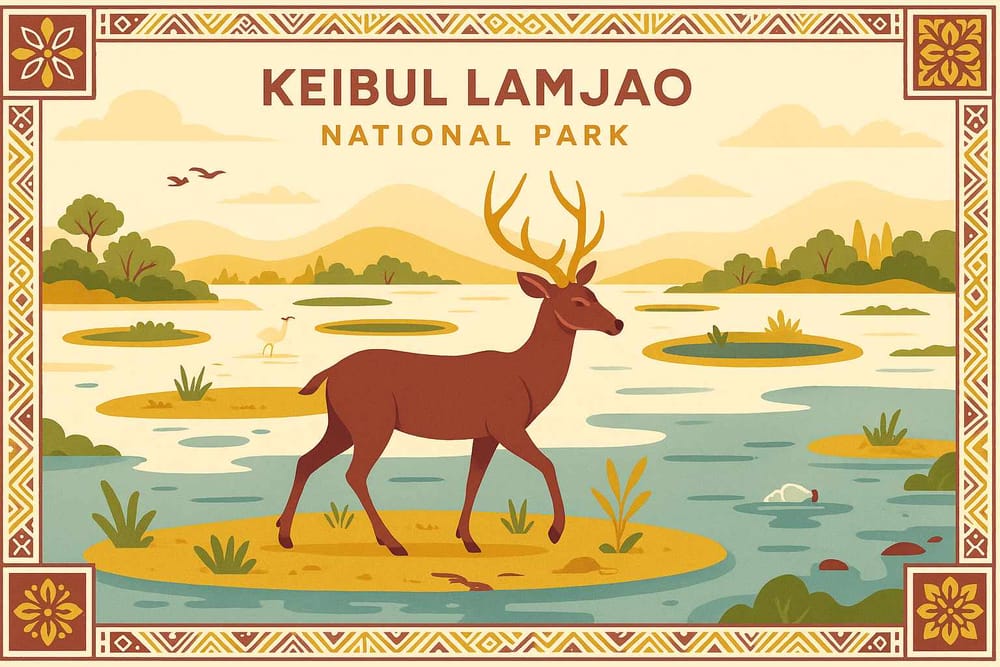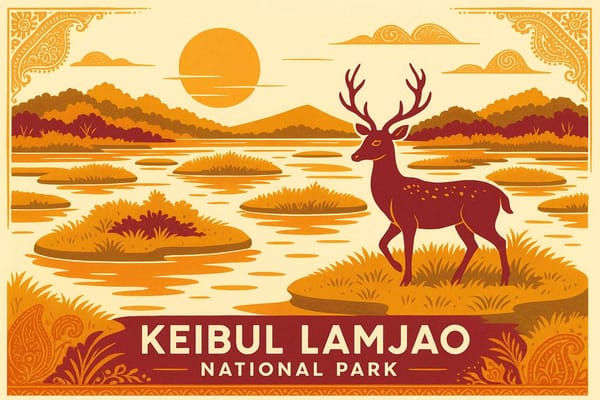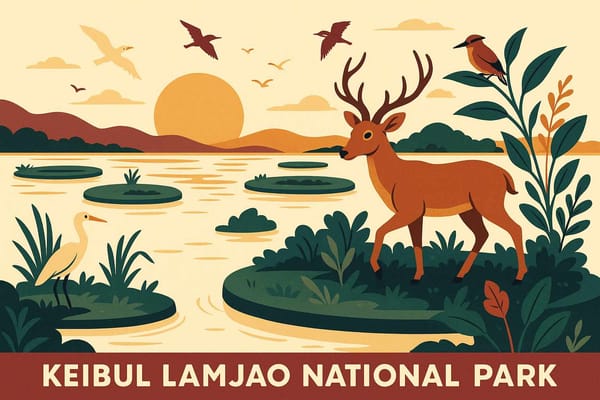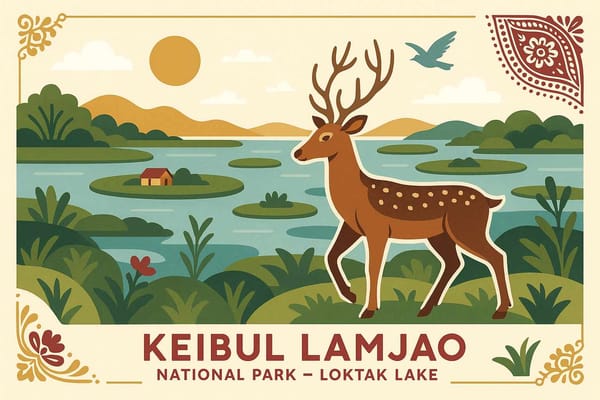
Keibul Lamjao National Park: This Ecosystem Faces Threats
Some places in India feel like they are touched by the divine. They hold a magic that goes beyond just scenic beauty; it’s a feeling of stepping into a living, breathing story. I felt this deeply when I learned about the Keibul Lamjao National Park in Manipur. Imagine a whole forest, a sanctuary, that doesn't stand on solid ground but floats gracefully on the shimmering waters of Loktak Lake. It sounds like a dream, doesn't it? But this incredible marvel is real, and it is the only one of its kind in the entire world.
This park is not just a geographical wonder; it is the last natural home of the gentle and beautiful Sangai deer, the pride of Manipur. This "dancing deer" leaps across the floating islands, a sight that connects you directly to the raw, untouched spirit of nature. Today, I want to take you on a journey to understand this fragile paradise, its unique ecosystem, the silent struggles it faces, and our role in protecting it.
What Breathes Life into This Floating World?
The secret behind Keibul Lamjao's magic lies in its unique 'phumdis'. Now, what are these? Phumdis are not just clumps of grass; they are intricate, floating islands made of soil, vegetation, and organic matter, all woven together over decades. They are so thick and strong that they support entire ecosystems, including the Sangai deer that graze upon them.
This floating sanctuary is a world in itself. It is home to:
- A Rich Tapestry of Life: Beyond the Sangai, the park is teeming with life. We are talking about over 400 species of animals and more than 100 species of birds that fill the air with their songs. The waters beneath the phumdis are rich with fish, which have been the lifeline for local communities for generations.
- The Embrace of Loktak Lake: The park’s existence is completely dependent on Loktak Lake, the largest freshwater lake in Northeast India. The lake acts like a nurturing mother, regulating the water levels and providing the foundation for the phumdis to thrive. This beautiful relationship between the land, water, and wildlife is what makes this park a global treasure. It reminds us of how interconnected life is, a concept deeply rooted in our own traditions, much like the spiritual ecosystem of places like Udaipur where nature and devotion are one.
Shadows Over the Floating Paradise: The Challenges Ahead
Like any precious treasure, Keibul Lamjao is facing serious threats that could unravel its delicate balance. What's causing this disturbance? Sadly, it's a mix of human intervention and environmental changes.
The construction of the Ithai Barrage on the Manipur River has been a major blow. It disrupted the natural ebb and flow of the lake's water. Think of it as changing the natural breathing cycle of the lake. This has made the phumdis thinner and weaker, endangering the very ground the Sangai deer walk on.
But the challenges don't end there. Pollution from surrounding areas and unsustainable human activities are slowly poisoning this pristine environment. Overfishing and the expansion of settlements on the phumdis are shrinking the natural habitat for the wildlife. This constant pressure has led to a heartbreaking decline in the Sangai deer population, pushing them closer to the brink of extinction. The thinning phumdis and loss of livelihood have also intensified the conflict between humans and wildlife, creating a cycle of struggle for both.
The Guardians of the Lake: Communities and Conservation
For centuries, the people living around Loktak Lake have shared a deep bond with its waters. Their lives, culture, and livelihoods are woven into the very fabric of this ecosystem. While some traditional practices have added to the ecological stress, it is these very communities that hold the key to the park's future.
Thankfully, a wave of change is coming. There's a growing understanding that protecting this park means protecting their own heritage. Government bodies, local communities, and conservation groups are now working hand-in-hand. Eco-awareness programs are teaching sustainable practices, and stricter rules are in place to protect the park's biodiversity. There's even a hopeful push to get Keibul Lamjao listed as a UNESCO World Heritage Site, which would bring it the global attention and protection it deserves.
Celebrating this unique bond, the annual Sangai Festival is a beautiful initiative that showcases the cultural pride tied to the deer and its home. It’s a wonderful example of how preserving heritage and nature can go together, creating a sustainable path forward.
At Bhaktilipi, our heart lies in preserving the timeless stories and devotional literature that form our cultural soul. We digitize these treasures to ensure they are not lost to time. In a similar spirit, protecting a natural wonder like Keibul Lamjao is about preserving a living, breathing story for the generations to come. If you feel connected to the cause of preserving our roots, you will find a home with us at Bhaktilipi.in.
Answering Your Curiosities about this Floating Wonder
Many people often ask, what exactly is it that makes Keibul Lamjao National Park float? The answer is the incredible 'phumdis' – those thick, buoyant mats of vegetation that sit on the surface of Loktak Lake, creating a solid-looking ground that is actually floating.
And why is the Sangai deer so precious to this place? The 'dancing deer', as it’s lovingly called, is not just an endangered species; it is a cultural symbol of Manipur. This park is its last remaining natural home, making its protection a matter of both ecological and emotional importance for the entire state.
You might also wonder, what are the biggest dangers the park faces today? The primary threats are the weakening of the phumdis due to altered water levels from the Ithai barrage, increasing pollution, and the shrinking of habitat due to human activities. These factors combined create a very fragile situation for the park's future.
So, what can we do to help? Spreading awareness is the first step. When we visit such places, practicing responsible tourism by not littering and respecting the local rules makes a huge difference. Supporting local communities that are adopting sustainable practices also contributes to the larger conservation effort.
A Shared Responsibility, A Gift to Cherish
Keibul Lamjao National Park is more than just a tourist spot; it's a testament to nature's incredible imagination and resilience. Its future, however, rests in our hands. It requires a collective effort from everyone – the government, the local people who call it home, and us, who admire its beauty from afar.
Let's work together to ensure that the Sangai deer continues to dance on its floating home, and Loktak Lake continues to breathe life into this magical ecosystem. This floating paradise is a gift, and it is our sacred duty to protect and cherish it for all time.
A passionate group of people dedicated to preserving India's knowledge of Dharma, Karma, and Bhakti for ourselves and the world 🙏.
Comments
Related in

Keibul Lamjao-The Only Floating National Park-A 2025 Guide
Imagine a place on Earth where the land itself breathes and sways upon the water. A place where deer don't just run, they seem to dance on floating meadows. This isn't a dream or a fairytale; this is the reality of Keibul Lamjao National Park in

Keibul Lamjao National Park Biodiversity: A Unique Exploration
Imagine a land that doesn't stay still, a forest that floats upon the water like a giant, sacred lotus leaf. This isn't a fable from our grandmothers' stories; this is the living, breathing miracle of Keibul Lamjao National Park in Manipur. It's a

Keibul Lamjao National Park-Wonders Await
Have you ever imagined a place where the very land you stand on is not solid ground, but a floating carpet of green, gently swaying on the water? It sounds like something from a dream or an ancient legend, but this place is very real. It’s a jewel nestled
